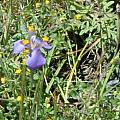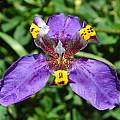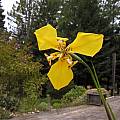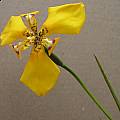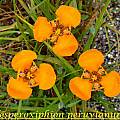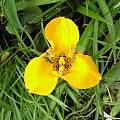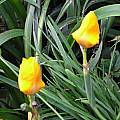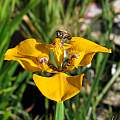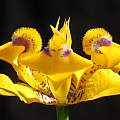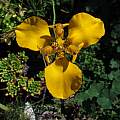Hesperoxiphion is a South American genus in the Iridaceae family closely related to Cypella and in fact some species have been transferred to that genus and back again.
Hesperoxiphion herrerae (Diels ex R.C.Foster) Ravenna is native to Peru. These plants were found near Cusco, Peru, flowering in open grassy fields in mid-March. The flowers were on 15-20 cm tall stems, and about 8 cm across; the leaves are pleated. Photos by Dave Brastow, (1) plant and habitat, (2) close-up of flower.
Hesperoxiphion peruvianum (Baker) Baker (syn. Cypella peruviana) Baker is native from Peru to Bolivia, has large flowers that are yellow, yellow brown, orange or plain yellow lined, or dotted red-brown or red-purple. The flowers are only open for part of a day, fading in the afternoon, but if the seed pods are nipped off the flowering season continues sometimes for months. In the wild they bloom from January to May and in 2003 there are some blooming in the Northern and Southern Hemispheres at the same time. This plant is dormant in winter and probably needs to be relatively dry at that time. Shoots appear in spring and will continue growing throughout summer. In coastal California, this species grows well in full sun and appreciates a dilute fertilizer during active growth. Nhu Nguyen grew a number of bulbs in a 1 gallon container for some years in low sunlight and the plants produced leaves but not flowers. When he moved them into a 3 gallon container and good sun, they started blooming very nicely. Height range: 45-60 cm.
The first two photos by Bob Rutemoeller of a yellow flowered form in the Northern Hemisphere August 2003 and the third by Bill Dijk of a multitude of orange flowers blooming just a little earlier in the Southern Hemisphere.
There are a few forms in cultivation. Photos 1-2 from Lee Poulsen taken September 2004 shows that even the buds are beautiful right before they open. Photos 3-5 by Nhu Nguyen show a different form. Photo 3 shows a flower with a hoverfly, a potential pollinator.
